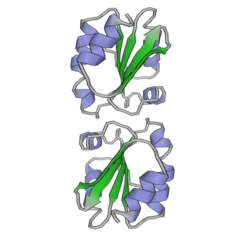1aiu: HUMAN THIOREDOXIN (D60N MUTANT, REDUCED FORM)
1auc: HUMAN THIOREDOXIN (OXIDIZED WITH DIAMIDE)
1cqg: HIGH RESOLUTION SOLUTION NMR STRUCTURE OF MIXED DISULFIDE INTERMEDIATE BETWEEN HUMAN THIOREDOXIN (C35A, C62A, C69A, C73A) MUTANT AND A 13 RESIDUE PEPTIDE COMPRISING ITS TARGET SITE IN HUMAN REF-1 (RESIDUES 59-71 OF THE P50 SUBUNIT OF NFKB), NMR, 31 STRUCTURES
1cqh: HIGH RESOLUTION SOLUTION NMR STRUCTURE OF MIXED DISULFIDE INTERMEDIATE BETWEEN HUMAN THIOREDOXIN (C35A, C62A, C69A, C73A) MUTANT AND A 13 RESIDUE PEPTIDE COMPRISING ITS TARGET SITE IN HUMAN REF-1 (RESIDUES 59-71 OF THE P50 SUBUNIT OF NFKB), NMR, MINIMIZED AVERAGE STRUCTURE
1ert: HUMAN THIOREDOXIN (REDUCED FORM)
1eru: HUMAN THIOREDOXIN (OXIDIZED FORM)
1erv: HUMAN THIOREDOXIN MUTANT WITH CYS 73 REPLACED BY SER (REDUCED FORM)
1erw: HUMAN THIOREDOXIN DOUBLE MUTANT WITH CYS 32 REPLACED BY SER AND CYS 35 REPLACED BY SER
1mdi: HIGH RESOLUTION SOLUTION NMR STRUCTURE OF MIXED DISULFIDE INTERMEDIATE BETWEEN MUTANT HUMAN THIOREDOXIN AND A 13 RESIDUE PEPTIDE COMPRISING ITS TARGET SITE IN HUMAN NFKB
1mdj: HIGH RESOLUTION SOLUTION NMR STRUCTURE OF MIXED DISULFIDE INTERMEDIATE BETWEEN HUMAN THIOREDOXIN (C35A, C62A, C69A, C73A) MUTANT AND A 13 RESIDUE PEPTIDE COMPRISING ITS TARGET SITE IN HUMAN NFKB (RESIDUES 56-68 OF THE P50 SUBUNIT OF NFKB)
1mdk: HIGH RESOLUTION SOLUTION NMR STRUCTURE OF MIXED DISULFIDE INTERMEDIATE BETWEEN HUMAN THIOREDOXIN (C35A, C62A, C69A, C73A) MUTANT AND A 13 RESIDUE PEPTIDE COMPRISING ITS TARGET SITE IN HUMAN NFKB (RESIDUES 56-68 OF THE P50 SUBUNIT OF NFKB)
1trs: THE HIGH-RESOLUTION THREE-DIMENSIONAL SOLUTION STRUCTURES OF THE OXIDIZED AND REDUCED STATES OF HUMAN THIOREDOXIN
1tru: THE HIGH-RESOLUTION THREE-DIMENSIONAL SOLUTION STRUCTURES OF THE OXIDIZED AND REDUCED STATES OF HUMAN THIOREDOXIN
1trv: THE HIGH-RESOLUTION THREE-DIMENSIONAL SOLUTION STRUCTURES OF THE OXIDIZED AND REDUCED STATES OF HUMAN THIOREDOXIN
1trw: THE HIGH-RESOLUTION THREE-DIMENSIONAL SOLUTION STRUCTURES OF THE OXIDIZED AND REDUCED STATES OF HUMAN THIOREDOXIN
2hsh: Crystal structure of C73S mutant of human thioredoxin-1 oxidized with H2O2
2hxk: Crystal structure of S-nitroso thioredoxin
2ifq: Crystal structure of S-nitroso thioredoxin
2iiy: Crystal structure of S-nitroso thioredoxin
3trx: HIGH-RESOLUTION THREE-DIMENSIONAL STRUCTURE OF REDUCED RECOMBINANT HUMAN THIOREDOXIN IN SOLUTION
4trx: HIGH-RESOLUTION THREE-DIMENSIONAL STRUCTURE OF REDUCED RECOMBINANT HUMAN THIOREDOXIN IN SOLUTION



























